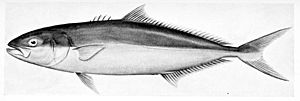Yellowtail amberjack facts for kids
Quick facts for kids Yellowtail amberjack |
|
|---|---|
 |
|
| Conservation status | |
| Scientific classification | |
| Synonyms | |
|
The yellowtail amberjack, also known as yellowtail kingfish, is a large and fast-swimming fish. You can find it in the Southern Ocean, but it also appears in northern waters at certain times of the year. This fish got its name from Monsieur de Lalande, a naturalist who first told scientists about it. The word Seriola is a bit of a mystery, but lalandi comes from his last name.
Contents
Meet the Yellowtail Amberjack
The yellowtail amberjack was officially described in 1833 by a French zoologist named Achille Valenciennes. He learned about the fish from another naturalist and explorer, Pierre Antoine Delalande, whose name is honored in the fish's scientific name. While some scientists think similar fish in the Northern Hemisphere are the same species, others believe they are different.
Where Do Yellowtail Amberjacks Live?
Yellowtail amberjacks live in warm and mild waters around the southern part of the world, and also in the northern Pacific Ocean. In Australia, for example, they are found along the coasts from Queensland down to Tasmania.
These fish often swim together in groups, like a school. Adult yellowtail amberjacks usually live near rocky reefs and sandy areas close to the coast. Sometimes, they even swim into estuaries, which are places where rivers meet the sea. They can be found in shallow water, but they have also been caught at depths of over 300 meters (about 1,000 feet).
Younger Fish vs. Older Fish
- Younger fish, weighing up to about 7 kilograms (15 pounds), often form large groups of hundreds of fish.
- These smaller fish usually stay close to the coast.
- Larger, older fish prefer deeper reefs and islands far from shore.
- Baby yellowtail amberjacks are rarely seen because they hide among floating plants or debris far out at sea.
- Young fish are yellow with black stripes, which helps them blend in. As they grow to about 30 centimeters (12 inches), their colors change to look like the adults.
Life and Habits of the Yellowtail Amberjack
Scientists don't know much about the early life of yellowtail amberjacks, like where the young fish live, how they travel, or how they reproduce in the wild. Adult fish live around rocky reefs and deep drop-offs in coastal waters. They can grow very large, sometimes up to 180 centimeters (about 6 feet) long!
Yellowtail Amberjack in Sydney Harbour
In the past, there were many yellowtail amberjacks in Sydney Harbour, Australia. However, when special traps were used for fishing in the 1970s, the number of large amberjacks dropped a lot. Because of concerns from people who enjoyed fishing for fun, these traps were later banned in Sydney Harbour in the mid-1990s.
Yellowtail Amberjack and People
The yellowtail amberjack is a good fish for aquaculture, which is like farming fish in water. Unlike some other types of amberjack, young Seriola lalandi are not easy to catch in the wild. Instead, they are raised from eggs in special fish farms called hatcheries.
In 2010, a company in South Australia was the biggest producer of farmed yellowtail amberjack in the world. Other places, like Western Australia, New Zealand, Chile, and Germany, are also trying to farm these fish. There are even plans for a new farm in the U.S. in 2022.
Most of the farmed yellowtail amberjack is sold to Japanese restaurants, where it's used to make sashimi, which is thinly sliced raw fish. You can also cook amberjack in many ways, like grilling it or drying it.
See also
In Spanish: Jurel de Castilla para niños


